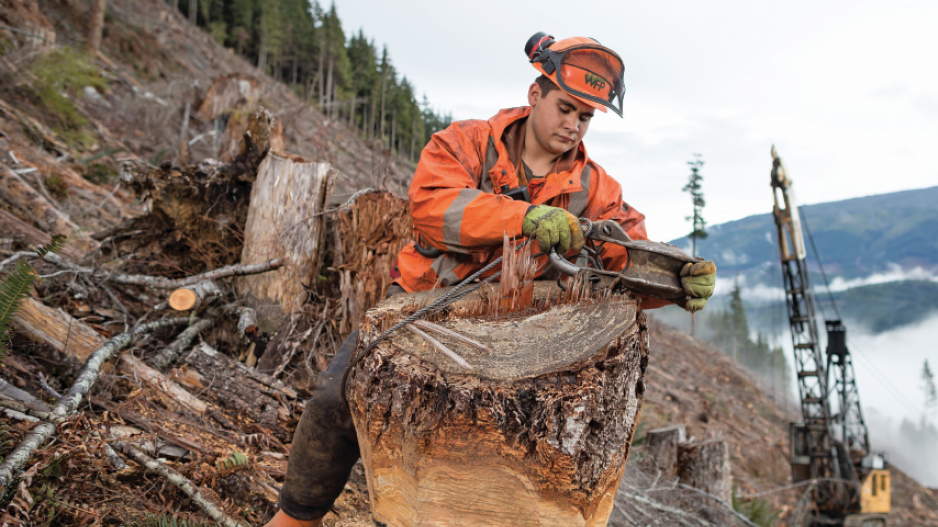Despite 10 years of committing itself to safe practices, WorkSafeBC says the B.C. forest industry still harbours a culture that accepts risk as part of the job.
The additional cost of safety is still an issue between contractors and licensees, and workers still feel they can be blacklisted for refusing to do work that they feel is unsafe.
They are not industry-wide problems, but Al Johnson, vice-president of prevention services at WorkSafeBC, said they’re enough of an issue that both forest companies and WorkSafeBC need to pay more attention to them.
Logging is dangerous work, and an acceptance of danger – loggers often feel they are expected to “suck it up” when faced with risk – is part of a culture that has existed for decades in the timber harvesting sector.
Despite commitments at the corporate level to safety, WorkSafeBC says it’s concerned that the message is not always getting to supervisors and workers. As logging moves into steeper terrain and all phases of logging activity squeeze into tighter areas, are these new challenges being met with a renewed commitment to safety?
They are tough issues to crack, Johnson said.
“What is the culture in that industry? Is it production over safety? We tend not to think so, and there is a lot of good work to ensure that safety is hand in hand with production.”
But he said it takes constant planning and supervision and a commitment by bull buckers who are supervising falling and logging activities to pay more than lip service to safety.
Initiatives being considered to create a safer industry include:
•benchmarking the safety culture and setting goals to improve it;
•incorporating an audit tool similar to the audits the sawmilling industry adopted to reduce risks from combustible dust; and
•undertaking quality control on faller supervisors.
Fallers in particular are vulnerable to being put into unsafe situations or being blacklisted for refusing unsafe work.
Each coastal faller is a one-man company and not protected from being dropped from a contractor’s list.
Johnson said workers have the right and the responsibility to refuse unsafe work under the Workers Compensation Act.
However, Port McNeill faller Dazy Weymer said workers should not be put in a position of being in conflict with their supervisor over safety in the first place.
“It’s the employers’ responsibility to give them a safe place to work. It’s complete abrogation of the employer’s responsibility to expect them to look after themselves, that they are going to shut an operation down, shut a machine down or shut themselves down.
“Those are huge decisions for the average working guy, but they are not huge decisions for a foreman. It’s a different reality both are working in. We need the right to refuse unsafe work, but as a general rule, if the worker is having to exercise his right to refuse unsafe work, then your management system has failed. The management system should not have put him in that position.”
Reynold Hert, chairman of the BC Forest Safety Council, said the refusal of unsafe work was part of an August 6 emergency meeting with industry. Workers not only have the right to refuse unsafe work but also have an obligation to refuse, which puts the onus back on management, he said.
Hert added that members of the forest safety council have made giant strides over the past decade by introducing programs like safe certification. The program assists companies in improving their safety performance and evaluates them through audits. The council represents 80% of the companies active in the logging business. That leaves one-fifth of the industry still outside the council and its safety initiatives.
David Elstone, executive director of the Truck Loggers Association (TLA), said safety oversight has not decreased among the contractors that his association represents. The proof, he said, is that the safety record overall has improved dramatically over the last decade. TLA members are among the safe-certified companies.
On issues like multiple-phase harvesting, where a number of logging phases take place at the same time on one cutblock, Elstone said his members have expressed a general concern that it has the potential to create workplace hazards.
“It creates challenges from a productivity perspective and a safety perspective.”
Situations change on the ground, requiring plans to change as well, he said.
“The trend is to download safety management to the contractor base, but there is a cost of managing safety, and that’s always a challenge.”
Hert said both licensees and contractors must recognize that the cost of safety needs to become standard from both the companies asking for the bid and the contractors submitting the bid.
Otherwise, they’re both taking huge liability risks, he said. Specifically, WorkSafeBC is now taking a more aggressive approach to safety industry-wide, and Bill C-45, an amendment to the Criminal Code, makes corporations criminally liable for safety violations that result in injury or death. •




